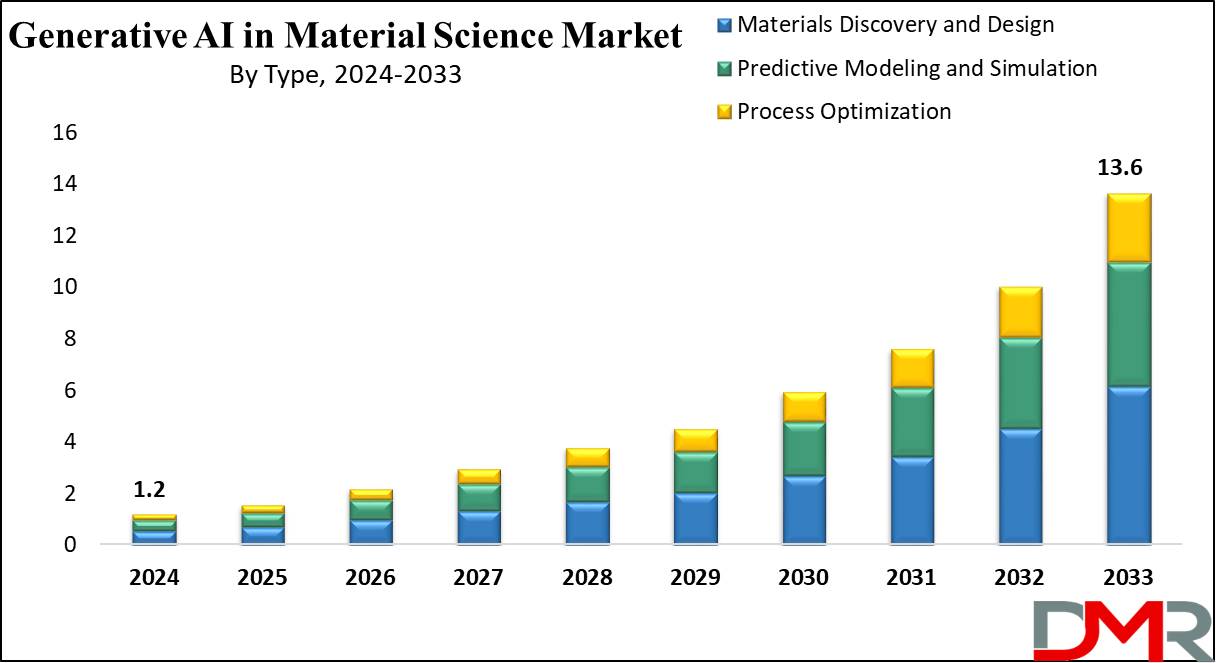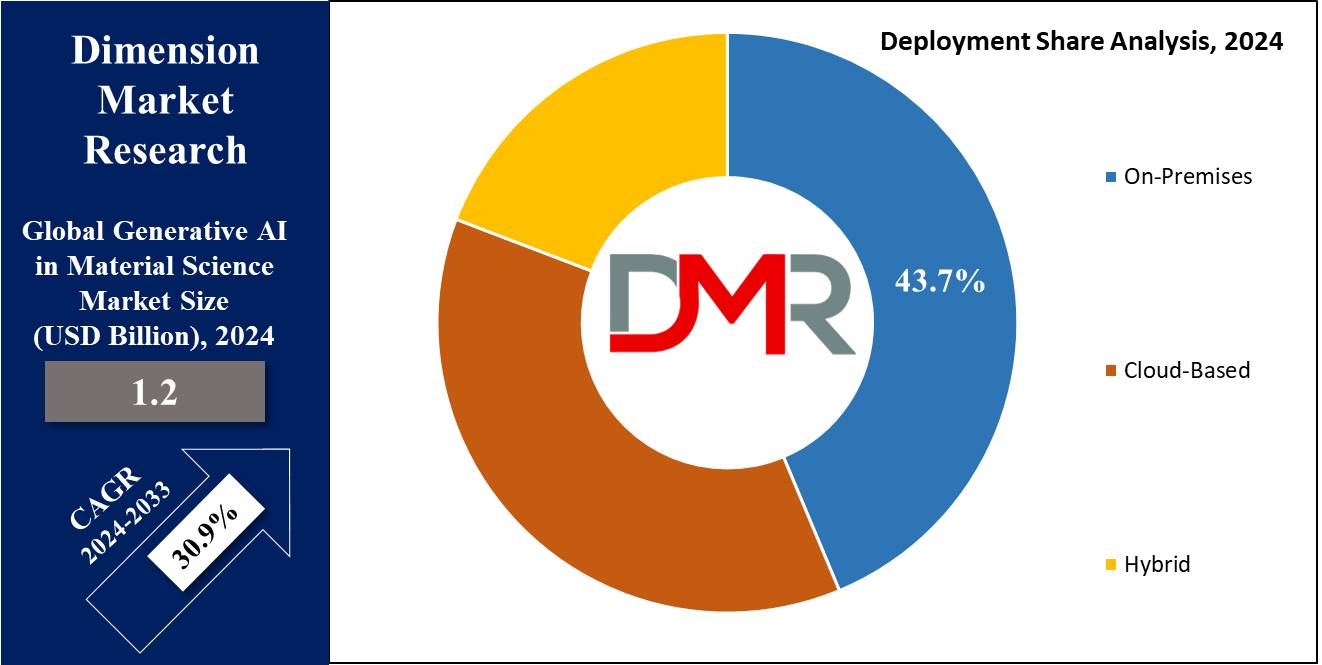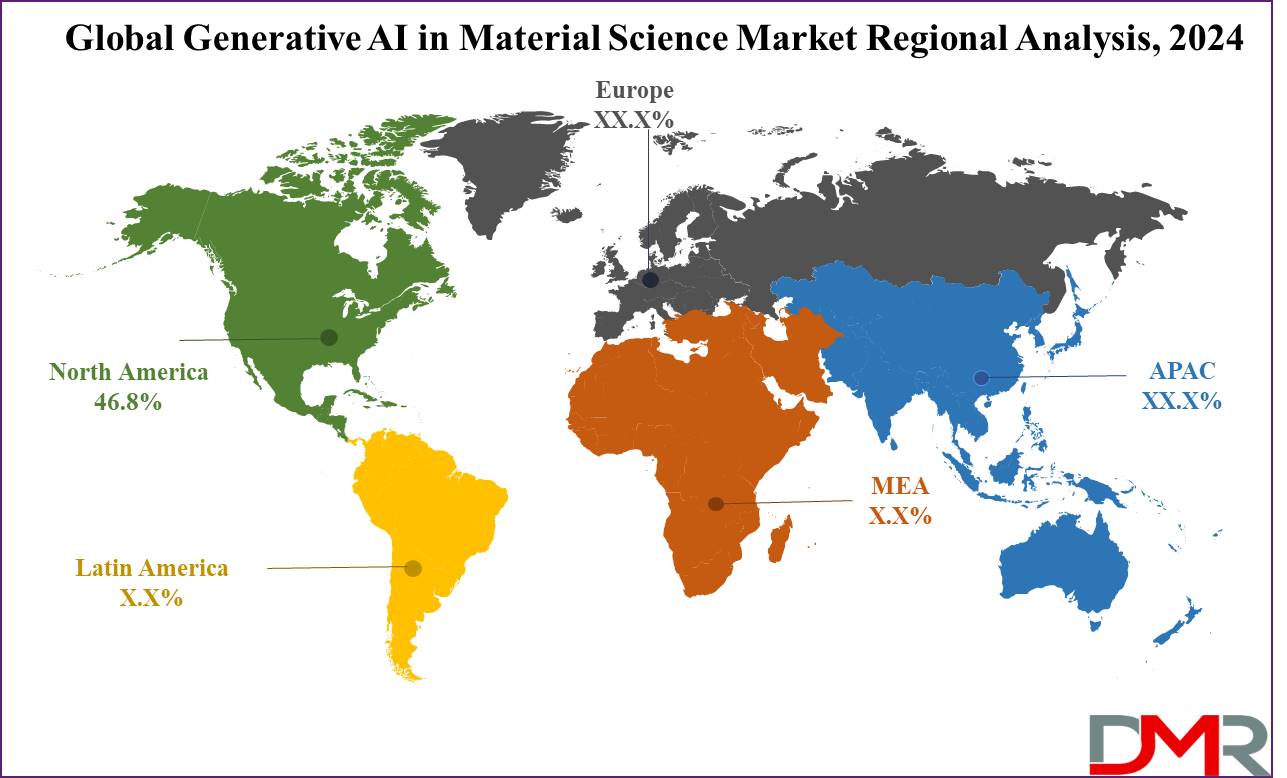Market Overview
The Global Generative AI in Material Science Market size is estimated to reach USD 1.2 billion in 2024 and is further predicted to reach USD 13.6 billion by 2033, at a CAGR of 30.9%.
Generative AI in Material Science is using AI techniques to design, discover, and optimize different materials using generative models like generative adversarial networks, or variational autoencoders. AI can generate new material designs, predict material properties, optimize material structures, and help with manufacturing or synthesis. It can be used to create new materials with specific mechanical, electrical, or chemical properties by speeding the development process and allowing for the discovery of new materials which is challenging through traditional methods.

AI transforms the overall process of manufacturing material science products by accelerating the discovery of materials, and flexible properties by increasing creativity in the material design and development process. It uses advanced machine learning algorithms to examine a large material data set, predict characteristics, and make innovative materials suitable for special purposes. Researchers are working on material behavior to improve predictive accuracy and create innovative materials that challenge the conventional design process of building materials. Scientists & engineers around the world are developing new materials more efficiently to fulfill the demands of various sectors like healthcare and aerospace.
Key Takeaways
- Market size: The global generative AI in material science market size is expected to grow by 12.1 billion, at a CAGR of 30.9 % during the forecasted period of 2025 to 2033.
- Market Definition: Generative AI in the Material Science Market is the process of including AI techniques in the manufacturing of materials to improve their properties.
- Type Analysis: Material Discovery & Design is projected to be the dominant force in the market, capturing the largest revenue share of 41.4% in 2024.
- Deployment Analysis: Cloud-based deployment is expected to witness significant growth with the highest revenue share of 45.6 % throughout the forecast period.
- Application Analysis: Pharmaceuticals and Chemicals are forecasted to hold the largest market share of 25.2% and dominate the generative AI in the material science market in 2024.
- Regional Analysis: North America is anticipated to dominate the generative AI in the material science market, capturing a revenue share of 46.8 % in 2024.
Use Cases
- Quality Control: AI algorithms and models are helpful in quality control processes by analyzing data from sensors and production parameters which detect imperfection or any variation in material properties.
- Virtual Screening: Generative AI helps in performing virtual screening of materials to identify materials with desired properties which saves a lot of time and resources as compared to traditional methods.
- Material Informatics: AI capable of analyzing a large dataset of materials properties, experimental results, and research papers to obtain valuable insight in less time and effort.
- Customized Material Design: Ai helps in the discovery and the designing of materials that aims to be built for a specific purpose or customer requirement like lightweight alloys for aerospace or biocompatible materials for medical implants.
Market Dynamic
Market Drivers
Fast Material Discovery- Generative AI in the material science market is fueling due to the fast discovery of new materials by researchers with the help of machine learning algorithms. Scientists can find new materials with the best properties without wasting a lot of time individually on each material as AI models are capable of exploring many different material options rapidly.
Improved Material performance- These AI models can improve the performance of products by optimizing different properties of the material. Researchers design new materials with aimed properties and anticipate the behavior of material accurately to fulfill the demand of the industry. They mainly focus on durability, strength, conductivity, flexibility, or other desired properties that contribute to the development of high-performance materials.
Market Restraints
Challenges with training data- There is a requirement for a vast amount of high-quality training data for AI algorithms which is difficult to obtain as there are no standard databases available, also the properties and characteristics of materials are not documented properly. The unavailability of training data hinders the capability, reliability, and accuracy of AI-generated outputs which poses a greater challenge to researchers.
Complex Properties and Materials Structure- Intricate atomic and molecular structures of material pose a challenge for the AI model to capture the complex structure accurately which is very important for generating insights and prediction. The material possesses different properties from the nanoscale to the macroscale which require comprehensive AI modeling to evaluate the behavior effectively.
Opportunities
Advanced material for a specific purpose-
Generative AI opens up extraordinary growth opportunities for creating advanced material that could be customized for specific purposes. Researchers are continuously focusing on refining material with different properties aimed at specific industries like energy storage, electronics, healthcare, and lightweight structures.
Empowering Materials Discovery with AI and Informatics- The merger of AI with material informatics possesses the potential to drive the growth in material science market. They use complex AI algorithms along with material databases to identify new materials with desired properties.
Market Trends
Adoption in different industries- The capability of generative AI to design and optimize materials with customized properties for specific purposes is driving its adoption and integration into many industries within materials science including healthcare, aerospace, automotive, and energy sectors.
Sustainable Solutions- Material science manufacturers and companies are using the
Artificial Intelligence model to develop eco-friendly materials, optimize resource use, reduce waste, and explore recyclable alternatives that align with global sustainability trends and customer preference for environment-friendly products.
Research Scope and Analysis
By Type
Material Discovery and Design segment is expected to dominate the Generative AI in the Material Science Market based on type with the largest revenue
share of 41.4% in 2024. The use of generative AI in material science is transforming the design and discovery of novel materials. They use computational models and machine-learning methods which enable researchers to develop new products and also optimize the composition, processing techniques, and properties of the material with desirable characteristics. These methods smoothen the research by predicting and accelerating material discovery, reducing initial costs, and improving the performance of material thereby transforming research practices.
Predictive modeling and Simulation are showing immense growth in generative AI for the material science market as they offer an accurate prediction of properties, behavior, and performance of the material. Researchers can obtain valuable insights into material behavior, and optimize processing conditions by employing data-driven techniques and computational simulations which accelerate the development of material with desired properties. Predictive techniques are useful in improving research efficiency, optimizing material designs, and advancing predictive capabilities in material science applications.
By Deployment
Cloud-based is forecasted to lead the generative AI in the material science market with the largest revenue share of 45.6% in 2024 as they offer various benefits like easy collaboration, portability, accessibility, computing power, and efficient data sharing across many locations, which leads to increase its resource efficiency and faster processing times. These deployments use cloud computing services to host and operate generative AI software, offering easy updates, maintenance, and cost-effectiveness.
They don’t need local infrastructure which makes it more adaptable and flexible to use as compared to on-premise deployment. Researchers can effectively employ and build generative AI models on cloud infrastructure in less processing time as compared to others. These platforms provide collaboration and knowledge shared by researchers from different locations which increases the process of material discovery and design process.

On-premise is expected to experience notable growth in the market as it allows organizations to control their data, security, and infrastructure in a better way. Researchers can access resources directly on on-premise data which ensures high-speed performance, and maximum work with the AI model. They offer improved data protection as they can restore sensitive information locally which reduces reliance on cloud storage. These deployments do not depend on cloud-based services as they involve installing generative AI software on the local server. They offer data privacy regulations, address intellectual property concerns related to material science data, and provide flexibility to customize infrastructure according to specific business requirements.
By Application
Generative AI in the Material Science Market as application is divided into Pharmaceuticals and Chemicals, Electronics and Semiconductors, Energy Storage and Conversion, Automotive and Aerospace, Construction and Infrastructure, Consumer Goods, and Others. Pharmaceuticals and Chemicals are anticipated to lead the market with the highest market share of 25.2 % by the end of 2024, due to the capability of generative AI to offer the creation of new chemical compounds and molecules with desired properties which helps in the process of chemical and drug delivery systems.
They can also analyze a lot of datasets to identify potential compounds and optimize their structures which accelerates the process of discovering promising molecules by reducing research time and costs.
Further, Electronics & Semiconductors are anticipated to experience notable growth throughout the forecasted period as researchers can explore various material properties and create products with improved electronic properties such as conductivity, bandgap, & durability. Products like flexible electronics, high-performance transistors, and optoelectronics are fueling the growth of this market in the electronics and semiconductor industries.
Energy storage & conversion contributes to the growth of this market by allowing the development of advanced materials and innovation in battery technologies, energy storage systems, and renewable energy devices. Construction & Infrastructure are notable in the growth of the market as they allow optimization and design of construction materials with improved properties like durability, strength, and sustainability.
The Generative AI in Material Science Market Report is segmented based on the following:
By Type
- Materials Discovery and Design
- Predictive Modeling and Simulation
- Process Optimization
By Deployment
- Cloud-Based
- On-Premises
- Hybrid
By Application
- Pharmaceuticals and Chemicals
- Electronics and Semiconductors
- Energy Storage and Conversion
- Automotive and Aerospace
- Construction and Infrastructure
- Consumer Goods
- Others
Regional Analysis
North America is expected to dominate the generative AI in the material science market
with the largest market share of 46.8 % by the end of 2024. This region is leading in the development and introduction of AI technologies across different industries notably within the material science sector. Many AI firms, research entities, and academic institutions in this region contribute to the expansion of this market. High emphasis on collaboration among researchers and industry and access to cutting-edge computing infrastructure, availability of vast funding opportunities in this region, collectively drive the expansion of the material science market.

Further, there is a huge pool of skilled professionals in data science,
machine learning, and AI due to the availability of leading universities, research institutions, & tech hubs in this region. In addition, strong technological infrastructure, high-speed internet connectivity, and availability of data centers in this region use complex AI algorithms for material science analysis.
Asia-Pacific is emerging as the fastest-growing region for Generative AI in Material Science Market due to heavy investment by the central government in AI research and development, strong manufacturing sector, and focus on technological innovation in countries like India, China, & Japan.
By Region
North America
Europe
- Germany
- The U.K.
- France
- Italy
- Russia
- Spain
- Benelux
- Nordic
- Rest of Europe
Asia-Pacific
- China
- Japan
- South Korea
- India
- ANZ
- ASEAN
- Rest of Asia-Pacific
Latin America
- Brazil
- Mexico
- Argentina
- Colombia
- Rest of Latin America
Middle East & Africa
- Saudi Arabia
- UAE
- South Africa
- Israel
- Egypt
- Rest of MEA
Competitive Landscape
Key market players in the generative AI in the material science market possess deep expertise in AI, machine learning, and material science R&D, propelling advancements in generative AI for research and development purposes. In addition, research institutions, universities, and startups significantly influence market dynamics through their expertise and innovative approach which increases the use of AI in various applications. Major players in this market include IBM Corporation, NVIDIA Corporation, Google LLC, Microsoft Corporation, and Siemens AG.
Research institutions and companies are actively expanding their product portfolios to gain a competitive advantage, particularly in fast-growing regions such as Asia Pacific. Microsoft Corporation's Azure AI platform provides tools and services for AI-driven material research, while Siemens AG specializes in AI-driven automation and industrial solutions, including applications in material science. These companies often form collaborate with research institutes, universities, and startups to new routes for generative AI in material science.
Some of the prominent players in the global generative AI in material science market are
- IBM
- Google DeepMind
- OpenAI
- Kebotix
- Matter
- MIT's Materials Project
- Schrödinger
- NVIDIA Corporation
- Siemens AG
- Others
Recent Development
- In November 2023, Graph Networks for Materials Exploration (GNoME), a new deep learning tool discovered 2.2 million new crystals, including 380,000 stable materials that could power future technologies.
- In July 2023, Orbital Materials, a startup based in London, aims to utilize generative AI, to speed up the advancement of clean energy solutions which focus on developing highly capable computer models that can identify optimal formulas for sustainable products such as eco-friendly jet fuel or batteries without relying on rare-earth minerals.
- In June 2023, Recursion Pharmaceuticals unveiled its utilization of artificial intelligence in the search for novel medications targeting Alzheimer’s and Parkinson’s diseases. The company's AI platform is designed to produce potential drug candidates with enhanced efficacy and reduced side effects compared to conventional drug discovery approaches.
- In March 2023, Quantum Generative Materials LLC, also known as GenMat, revealed the development of ZENO, a proprietary generative artificial intelligence that is capable of creating new material in less time compared to conventional methods and also improves essential properties like electrical and thermal conductivity, heat capacity, the density of states.
Report Details
| Report Characteristics |
| Market Size (2024) |
USD 12.Bn |
| Forecast Value (2033) |
USD 13.6 Bn |
| CAGR (2023-2032) |
30.9% |
| Historical Data |
2018 – 2023 |
| Forecast Data |
2024 – 2033 |
| Base Year |
2023 |
| Estimate Year |
2024 |
| Report Coverage |
Market Revenue Estimation, Market Dynamics, Competitive Landscape, Growth Factors and etc. |
| Segments Covered |
By Type (Materials Discovery and Design, Predictive Modeling and Simulation, and Process Optimization), By Deployment (On-Premises, Cloud-Based, and Hybrid), By Application (Pharmaceuticals and Chemicals, Electronics and Semiconductors, Energy Storage and Conversion, Automotive and Aerospace, Construction and Infrastructure, Consumer Goods, and Others ) |
| Regional Coverage |
North America – The US and Canada; Europe – Germany, The UK, France, Russia, Spain, Italy, Benelux, Nordic, & Rest of Europe; Asia- Pacific– China, Japan, South Korea, India, ANZ, ASEAN, Rest of APAC; Latin America – Brazil, Mexico, Argentina, Colombia, Rest of Latin America; Middle East & Africa – Saudi Arabia, UAE, South Africa, Turkey, Egypt, Israel, & Rest of MEA |
| Prominent Players |
IBM, Google DeepMind, OpenAI, Kebotix, Matter, MIT's Materials Project, Schrödinger, and Other Key Players |
| Purchase Options |
We have three licenses to opt for: Single User License (Limited to 1 user), Multi-User License (Up to 5 Users), and Corporate Use License (Unlimited User) along with free report customization equivalent to 0 analyst working days, 3 analysts working days and 5 analysts working days respectively. |
Frequently Asked Questions
The Global Generative AI in the Material Science Market size is estimated to have a value of USD 1.2 billion in 2024 and is expected to reach USD 13.6 billion by the end of 2033.
North America is expected to be the largest market share for the Global Generative AI in the Material Science Market with a share of about 46.8% in 2024.
Some of the major key players in the Global Generative AI in the Material Science Market are IBM, Google DeepMind, OpenAI, and many others.
The market is growing at a CAGR of 30.9 percent over the forecasted period.